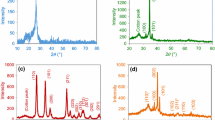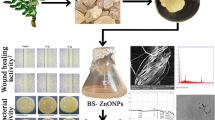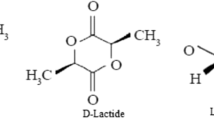Abstract
Protection against bacterial contamination remains a demand for healthcare textiles such as wound dressings to reduce or eliminate hospital-acquired infections related to antibiotic-resistant bacteria. We report herein a simple and straightforward in situ approach to deposit copper oxide and titanium oxide nanoparticles onto cotton fabric using a sonochemical-mediated sol–gel method. Modification of the cotton surface was achieved by incorporation of citric acid (CA) and polyethylene glycol (PEG) to improve the attachment of the nanoparticles and reduce the attachment of bacteria to the cotton surface, respectively. The resultant cotton fabric was used against Escherichia coli as a Gram-negative bacterium and Staphylococcus aureus as a Gram-positive bacterium in dark condition as an in vitro model for treatment of bacterial wound infection. The effects of different treatment parameters including duration and frequency of ultrasonic irradiation, surface modification with PEG and/or CA, and cotton chemical composition with different metal oxide molar ratios on the antibacterial activity of the treated cotton fabric were studied. All treated cotton fabrics showed antibacterial activity, with higher efficiency for those coated with CuO or CuO/TiO2 (1:1 molar ratio) among the single metal oxide and composite-modified cotton fibers, respectively. Our results show that such functionalized cotton fibers could actively fight the spread of bacterial infections by preventing bacterial adhesion, enabling more efficient bonding, and ultrasonically promoting generation of nanoparticles and their strong adhesion to the fabric surface.








Similar content being viewed by others
References
Lim, SH, Hudson, SM, “Application of a Fiber-Reactive Chitosan Derivative to Cotton Fabric as an Antimicrobial Textile Finish.” Carbohydr. Polym., 56 227–234 (2004)
Fei, B, Deng, Z, Xin, JH, Zhang, Y, Pang, G, “Room Temperature Synthesis of Rutile Nanorods and Their Applications on Cloth.” Nanotechnology, 17 1927–1931 (2006)
Nonami, T, Hase, H, Funakoshi, K, “Apatite-Coated Titanium Dioxide Photocatalyst for Air Purification.” Catal. Today, 96 113–118 (2004)
Qi, K, Daoud, WA, Xin, JH, et al., “Self-Cleaning Cotton.” J. Mater. Chem., 16 4567–4574 (2006)
Foster, HA, Ditta, IB, Varghese, S, Steele, A, “Disinfection Using Titanium Dioxide: Spectrum and Mechanism of Antimicrobial Activity.” Appl. Microbiol. Biotechnol., 90 847–868 (2011)
Karunakaran, C, Abiramasundari, G, Gomathisankar, P, et al., “Cu-Doped TiO2 Nanoparticles for Photocatalytic Disinfection of Bacteria Under Visible Light.” Colloid Interface Sci., 352 68–74 (2010)
Pham, T-D, Lee, B-K, “Cu Doped TiO2/GF for Photocatalytic Disinfection of Escherichia coli in Bioaerosols Under Visible Light Irradiation: Application and Mechanism.” Appl. Surf. Sci., 296 15–23 (2014)
Khan, MM, Ansari, SA, Pradhan, D, et al., “Band Gap Engineered TiO2 Nanoparticles for Visible Light Induced Photoelectrochemical and Photocatalytic Studies.” J. Mater. Chem. A, 2 637–644 (2014)
Yadav, HM, Otari, SV, Bohara, RA, et al., “Synthesis and Visible Light Photocatalytic Antibacterial Activity of Nickel-Doped TiO2 Nanoparticles Against Gram-Positive and Gram-Negative Bacteria.” J. Photochem. Photobiol. A Chem., 15 130–136 (2014)
Ashkarran, AA, Hamidinezhad, H, Haddadi, H, et al., “Double-Doped TiO2 Nanoparticles as an Efficient Visible-Light-Active Photocatalyst and Antibacterial Agent Under Solar Simulated Light.” Appl. Surf. Sci., 301 (15) 338–345 (2014)
Ananpattarachai, J, Boonto, Y, Kajitvichyanukul, P, “Visible Light Photocatalytic Antibacterial Activity of Ni-Doped and N-Doped TiO2 on Staphylococcus aureus and Escherichia coli Bacteria.” Environ. Sci. Pollut. Res., (2015). doi:10.1007/s11356-015-4775-1
Hostynek, JJ, Maibach, HI, “Copper Hypersensitivity: Dermatologic Aspects—An Overview.” Rev. Environ. Health, 18 (3) 153–183 (2003)
Uauy, R, Olivares, M, Gonzalez, M, “Essentiality of Copper in Humans.” Am. J. Clin. Nutr., 67 952S–959S (1998)
Pereira, CE, Felcman, E, “Correlation Between Five Minerals and the Healing Effect of Brazilian Medicinal Plants.” J. Biol. Trace Elem. Res., 65 251–259 (1998)
Micheals, HT, “Anti-microbial Characteristics of Copper.” Stand. News, 34 28–31 (2006)
Hostynek, JJ, Dreher, F, Maibach, HI, “Human Stratum Corneum Penetration by Copper: In vivo Study After Occlusive and Semi-Occlusive Application of the Metal as Powder.” Food Chem. Toxicol., 44 1539–1543 (2006)
Pickart, L, “The Human Tri-peptide GHK and Tissue Remodeling.” J. Biomater. Sci. Polym. Ed., 19 969–988 (2008)
Borkow, G, Gabbay, J, Zatcoff, RC, “Could Chronic Wounds Not Heal Due to Too Low Local Copper Levels?” Med. Hypotheses, 70 610–613 (2008)
Chen, S, Guo, Y, Chen, S, et al., “Fabrication of Cu/TiO2 Nanocomposite: Toward an Enhanced Antibacterial Performance in the Absence of Light.” Mater. Lett., 83 154–157 (2012)
Baghriche, O, Rtimi, S, Pulgarin, C, et al., “Innovative TiO2/Cu Nanosurfaces Inactivating Bacteria in the Minute Range Under Low-Intensity Actinic Light.” ACS Appl. Mater. Interfaces, 10 5234–5240 (2012)
Schmidt, F, Fischer, A, Haufe, H, Leisegang, T, Mahltig, B, “Solvothermally Prepared Copper Modified TiO2 Composite Sols—A Coating Agent for Textiles to Realize Photocatalytic Active and Antimicrobial Fabrics” Chapter 13 in: Textiles: Types, Uses and Production Methods, pp. 439–466. Nova Science Publishers Inc., (2012)
Ramesh, S, Koltypin, Y, Prozorov, R, et al., “Sonochemical Impregnation of Submicron Silica Spheres with Ni Nanoparticles.” Chem. Mater., 9 546–551 (1997)
Sadr, FA, Montazer, M, “In situ Sonosynthesis of Nano TiO2 on Cotton Fabric.” Ultrason. Sonochem., 21 681–691 (2014)
Prasad, K, Pinjari, DV, Pandit, AB, et al., “Phase Transformation of Nanostructured Titanium Dioxide from Anatase-To-Rutile via Combined Ultrasound Assisted Sol–Gel Technique.” Ultrason. Sonochem., 17 409–415 (2010)
Prasad, K, Pinjari, DV, Pandit, AB, et al., “Synthesis of Titanium Dioxide by Ultrasound Assisted Sol–Gel Technique: Effect of Amplitude (Power Density) Variation.” Ultrason. Sonochem., 17 697–703 (2010)
Ghows, N, Entezari, MH, “Fast and Easy Synthesis of Core-Shell Nanocrystals (CdS/TiO2) at Low Temperature by Micro-Emulsion Under Ultrasound.” Ultrason. Sonochem., 18 629–634 (2011)
Guo, J, Zhu, S, Chen, Z, et al., “Sonochemical Synthesis of TiO2 Nanoparticles on Graphene for Use as Photocatalyst.” Ultrason. Sonochem., 18 1082–1090 (2011)
Nguyen, QV, “Hospital-Acquired Infections” (2006). http://www.emedicine.com/ped/topic1691.htm. Accessed 21 April 2008
Hospital-Acquired Infections-Trends Across Europe, Frost and Sullivan,/http://www.reportlinker.com/p0249335-summary/Hospital-acquired-infections-trends-across-Europe.htmlS; June 2010. Accessed 1 Nov 2012
Kyriacou, SV, Brownlow, WJ, Xu, XH, “Using Nanoparticle Optics Assay for Direct Observation of Function of Antimicrobial Agents in Single Live Bacterial Cells.” Biochemistry, 43 140–147 (2004)
Selvam, S, Sundrarajan, M, “Functionalization of Cotton Fabric with PVP/ZnO Nanoparticles for Improved Reactive Dyeability and Antibacterial Activity.” Carbohydr. Polym., 87 1419–1424 (2012)
Cheng, Q, Li, C, Pavlinek, V, et al., “Surface-Modified Antibacterial TiO2/Ag Nanoparticles: Preparation and Properties.” Appl. Surf. Sci., 252 4154–4160 (2006)
Boekema, BKHL, Pool, L, Ulrich, MMW, “The Effect of a Honey Based Gel and Silver Sulphadiazine on Bacterial Infections of In Vitro Burn Wounds.” Burns, 39 754–759 (2013)
Gupta, B, Arora, A, Saxena, S, et al., “Preparation of Chitosan–Polyethylene Glycol Coated Cotton Membranes for Wound Dressings: Preparation and Characterization.” Polym. Adv. Technol., 20 58–65 (2009)
Shingel, KI, Di Stabile, L, Marty, JP, et al., “Inflammatory Inert Poly(ethylene glycol)–Protein Wound Dressing Improves Healing Responses In Partial- and Full-Thickness Wounds.” Int. Wound J., 3 332–342 (2006)
Sinha, M, Banik, RM, Haldar, C, et al., “Development of Ciprofloxacin Hydrochloride Loaded Poly(Ethylene Glycol)/Chitosan Scaffold as Wound Dressing.” J. Porous Mater., 20 799–807 (2013)
Bader, RA, Herzog, KT, Kao, WJ, “A Study of Diffusion in Poly(Ethyleneglycol)-Gelatin Based Semi-Interpenetrating Networks for Use in Wound Healing.” Polym. Bull., 62 381–389 (2009)
Klemm, D, Heublein, B, Fink, H-P, et al., “Cellulose: Fascinating Biopolymer and Sustainable Raw Material.” Angew. Chem. Int. Ed., 44 3358–3393 (2005)
Jin, C, Jiang, Y, Niu, T, Huang, J, “Cellulose-Based Material with Amphiphobicity to Inhibit Bacterial Adhesion by Surface Modification.” Mater. Chem., 22 2562–12567 (2012)
Huang, J, Gu, Y, “Self-Assembly of Various Guest Substrates in Natural Cellulose Substances to Functional Nanostructured Materials.” Curr. Opin. Colloid Interface Sci., 16 470–481 (2011)
Alongi, J, Ciobanu, M, Tata, J, et al., “Thermal Stability and Flame Retardancy of Polyester, Cotton, and Relative Blend Textile Fabrics Subjected to Sol-Gel Treatments.” J. Appl. Polym. Sci., 119 1961–1969 (2011)
Uddin, MJ, Cesano, F, Bonino, F, et al., “A Tailoring the Activity of Ti-Based Photocatalysts by Playing with Surface Morphology and Silver Doping.” J. Photochem. Photobiol. A Chem., 196 165–173 (2008)
Bauer, W, Kirby, WM, Sherris, JC, et al., “Antibiotic Susceptibility Testing by a Standardized Single Disk Method.” Am. J. Clin. Pathol., 45 493–496 (1966)
Gao, Y, Cranston, R, “Recent Advances in Antimicrobial Treatments of Textiles.” Text. Res. J., 8 60–72 (2008)
Perelshtein, I, Applerot, G, Perkas, N, et al., “A One-Step Process for the Antimicrobial Finishing of Textiles with Crystalline TiO2 Nanoparticles.” Chem. Eur. J., 18 4575–4582 (2012)
Applerot, G, Lellouche, J, Lipovsky, A, et al., “Understanding the Antibacterial Mechanism of CuO Nanoparticles: Revealing the Route of Induced Oxidative Stress.” Small, 8 3326–3337 (2012)
Gunawan, C, Teoh, WY, Marquis, CP, et al., “Cytotoxic Origin of Copper (II) Oxide Nanoparticles: Comparative Studies with Micron-Sized Particles, Leachate, and Metal Salts.” ACS Nano., 5 7214–7225 (2011)
Ludmil, T, Benov, S, Fridovich, I, “Escherichia coli Expresses a Copper- and Zinc Containing Superoxide Dismutase.” J. Biol. Chem., 269 25310–25314 (1994)
Hu, XK, Cook, S, Wang, P, Hwang, HM, “In Vitro Evaluation of Cytotoxicity of Engineered Metal Oxide Nanoparticles.” Sci. Total Environ., 407 3070–3072 (2009)
Orhan, M, Kut, D, Gunesoglu, C, “Improving the Antibacterial Activity of Cotton Fabrics Finished with Triclosan by the Use of 1,2,3,4-Butanetetracarboxylic Acid and Citric Acid.” J. Appl. Polym. Sci., 111 1344–1352 (2009)
Banerjee, I, Pangule, RC, Kane, RS, “Antifouling Coatings: Recent Developments in the Design of Surfaces that Prevent Fouling by Proteins, Bacteria, and Marine Organisms.” Adv. Mater., 23 690–718 (2011)
Kenawy, E-R, Worley, SD, Broughton, R, “The Chemistry and Applications of Antimicrobial Polymers: A State-of-the-Art Review.” Biomacromolecules, 8 1359–1384 (2007)
Wach, J-Y, Bonazzi, S, Gademann, K, “Antimicrobial Surfaces Through Natural Product Hybrids.” Angew. Chem. Int. Ed., 47 7123–7126 (2008)
Dexter, SC, Sullivan, JD, William, J, Watson, SW, “Influence of Substrate Wettability on the Attachment of Marine Bacteria to Various Surfaces.” Appl. Microbiol., 30 298–308 (1975)
Adams, AP, Santschi, EM, Mellencamp, MA, “Antibacterial Properties of a Silver Chloride-Coated Nylon Wound Dressing.” Vet. Surg., 28 219–225 (1999)
Kingshott, P, Griesser, HJ, “Surfaces that Resist Bioadhesion.” Curr. Opin. Solid State Mater. Sci., 4 403–412 (1999)
Liu, Y, Kim, H-I, “Characterization and Antibacterial Properties of Genipin-Crosslinked Chitosan/Poly(Ethylene Glycol)/ZnO/Ag Nanocomposites.” Carbohydr. Polym., 89 (1) 111–116 (2012)
Park, KD, Kim, YS, Han, DK, “Bacterial Adhesion on PEG Modified Polyurethane Surfaces.” Biomaterials, 19 (7) 851–859 (1998)
Harris, JM, Poly(Ethylene Glycol) Chemistry: Biotechnical and Biomedical Applications. Plenum, New York (1992)
Wu, B, Huang, R, Sahu, M, Feng, X, Biswas, P, Tang, YJ, “Cu-Doped TiO2 Nanoparticles Enhance Survival of Shewanella oneidensis MR-1 Under Ultraviolet Light (UV) Exposure.” Sci. Total Environ., 408 1755–1758 (2010)
Hassan, MS, Amna, T, Kim, HY, Khil, M-S, “Enhanced Bactericidal Effect of Novel CuO/TiO2 Composite Nanorods and a Mechanism Thereof.” Compos. Part B, 45 904–910 (2013)
Guo, YG, Cao, FF, Xin, S, Wan, LJ, “Wet Chemical Synthesis of Cu/TiO2 Anocomposites with Integrated Nano-Current-Collectors as High-Rate Anode Materials in Lithium-Ion Batteries.” Phys. Chem. Chem. Phys., 13 2014–2020 (2011)
Perelshtein, I, Applerot, G, Perkas, N, et al., “CuO-Cotton Nanoparticles: Formation, Morphology and Antibacterial Activity.” Surf. Coat. Technol., 204 54–57 (2009)
Borkow, G, Gavia, J, “Copper as a Biocidal Tool.” Curr. Med. Chem., 12 2163–2175 (2005)
Stoimenov, PK, Klinger, RL, Marchin, GL, Klabunde, KJ, “Metal Oxide Nanoparticles as Bactericidal Agents.” Langmuir, 18 6679–6686 (2002)
Gao, Y, Cranston, R, “Recent Advances in Antimicrobial Treatments of Textiles.” Text. Res. J., 78 (1) 60–72 (2008)
Han, S, Yang, Y, “Antimicrobial Activity of Wool Fabric Treated with Curcumin.” Dyes Pigm., 64 157–161 (2005)
Meilert, KT, Laub, D, Kiwi, J, “Photocatalytic Self-Cleaning of Modified Cotton Textiles by TiO2 Clusters Attached by Chemical Spacers.” J. Mol. Catal. A Chem., 237 101–108 (2005)
Yuranova, T, Laub, D, Kiwi, J, “Synthesis, Activity and Characterization of Textiles Showing Self-Cleaning Activity Under Daylight Irradiation.” Catal. Today, 122 109–117 (2007)
Nazari, A, Montazer, M, Yazdanshenas, ME, et al., “Nano TiO2 Photo-Catalyst and Sodium Hypophosphite for Cross-Linking Cotton with Poly Carboxylic Acids Under UV and High Temperature.” Appl. Catal. A Gen., 371 10–16 (2009)
Acknowledgments
The authors are grateful to Islamic Azad University, Shahreza Branch for financial support to carry out this project.
Author information
Authors and Affiliations
Corresponding author
Rights and permissions
About this article
Cite this article
Khani, A., Talebian, N. In vitro bactericidal effect of ultrasonically sol–gel-coated novel CuO/TiO2/PEG/cotton nanocomposite for wound care. J Coat Technol Res 14, 651–663 (2017). https://doi.org/10.1007/s11998-016-9870-9
Published:
Issue Date:
DOI: https://doi.org/10.1007/s11998-016-9870-9




